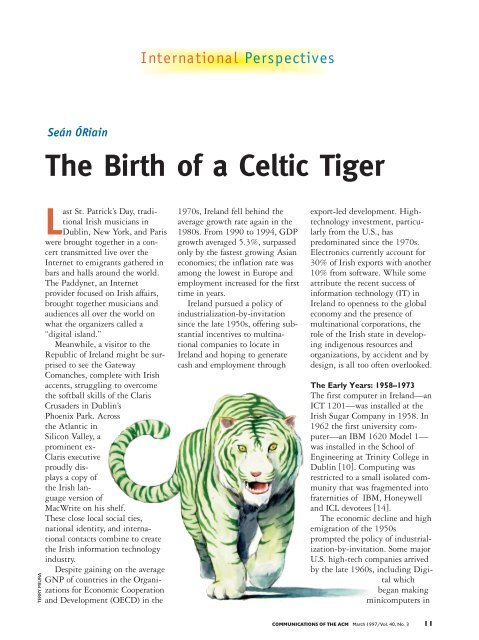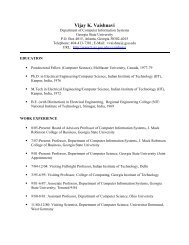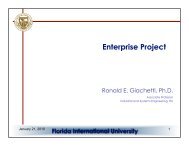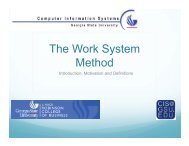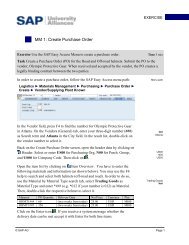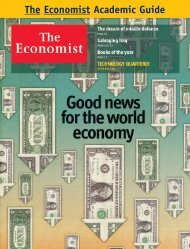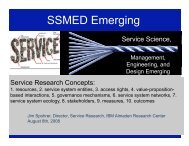The Birth of a Celtic Tiger - Department of Computer Information ...
The Birth of a Celtic Tiger - Department of Computer Information ...
The Birth of a Celtic Tiger - Department of Computer Information ...
You also want an ePaper? Increase the reach of your titles
YUMPU automatically turns print PDFs into web optimized ePapers that Google loves.
International Perspectives<br />
Seán ÓRiain<br />
<strong>The</strong> <strong>Birth</strong> <strong>of</strong> a <strong>Celtic</strong> <strong>Tiger</strong><br />
TERRY MIURA<br />
Last St. Patrick’s Day, traditional<br />
Irish musicians in<br />
Dublin, New York, and Paris<br />
were brought together in a concert<br />
transmitted live over the<br />
Internet to emigrants gathered in<br />
bars and halls around the world.<br />
<strong>The</strong> Paddynet, an Internet<br />
provider focused on Irish affairs,<br />
brought together musicians and<br />
audiences all over the world on<br />
what the organizers called a<br />
“digital island.”<br />
Meanwhile, a visitor to the<br />
Republic <strong>of</strong> Ireland might be surprised<br />
to see the Gateway<br />
Comanches, complete with Irish<br />
accents, struggling to overcome<br />
the s<strong>of</strong>tball skills <strong>of</strong> the Claris<br />
Crusaders in Dublin’s<br />
Phoenix Park. Across<br />
the Atlantic in<br />
Silicon Valley, a<br />
prominent ex-<br />
Claris executive<br />
proudly displays<br />
a copy <strong>of</strong><br />
the Irish language<br />
version <strong>of</strong><br />
MacWrite on his shelf.<br />
<strong>The</strong>se close local social ties,<br />
national identity, and international<br />
contacts combine to create<br />
the Irish information technology<br />
industry.<br />
Despite gaining on the average<br />
GNP <strong>of</strong> countries in the Organizations<br />
for Economic Cooperation<br />
and Development (OECD) in the<br />
1970s, Ireland fell behind the<br />
average growth rate again in the<br />
1980s. From 1990 to 1994, GDP<br />
growth averaged 5.3%, surpassed<br />
only by the fastest growing Asian<br />
economies; the inflation rate was<br />
among the lowest in Europe and<br />
employment increased for the first<br />
time in years.<br />
Ireland pursued a policy <strong>of</strong><br />
industrialization-by-invitation<br />
since the late 1950s, <strong>of</strong>fering substantial<br />
incentives to multinational<br />
companies to locate in<br />
Ireland and hoping to generate<br />
cash and employment through<br />
export-led development. Hightechnology<br />
investment, particularly<br />
from the U.S., has<br />
predominated since the 1970s.<br />
Electronics currently account for<br />
30% <strong>of</strong> Irish exports with another<br />
10% from s<strong>of</strong>tware. While some<br />
attribute the recent success <strong>of</strong><br />
information technology (IT) in<br />
Ireland to openness to the global<br />
economy and the presence <strong>of</strong><br />
multinational corporations, the<br />
role <strong>of</strong> the Irish state in developing<br />
indigenous resources and<br />
organizations, by accident and by<br />
design, is all too <strong>of</strong>ten overlooked.<br />
<strong>The</strong> Early Years: 1958–1973<br />
<strong>The</strong> first computer in Ireland—an<br />
ICT 1201—was installed at the<br />
Irish Sugar Company in 1958. In<br />
1962 the first university computer—an<br />
IBM 1620 Model 1—<br />
was installed in the School <strong>of</strong><br />
Engineering at Trinity College in<br />
Dublin [10]. Computing was<br />
restricted to a small isolated community<br />
that was fragmented into<br />
fraternities <strong>of</strong> IBM, Honeywell<br />
and ICL devotees [14].<br />
<strong>The</strong> economic decline and high<br />
emigration <strong>of</strong> the 1950s<br />
prompted the policy <strong>of</strong> industrialization-by-invitation.<br />
Some major<br />
U.S. high-tech companies arrived<br />
by the late 1960s, including Digital<br />
which<br />
began making<br />
minicomputers in<br />
COMMUNICATIONS OF THE ACM March 1997/Vol. 40, No. 3 11
Galway in 1971. This policy’s<br />
success is questionable as companies<br />
created mainly low-skilled<br />
jobs, developed few linkages to<br />
the local economy, and <strong>of</strong>ten left<br />
once their tax breaks ended.<br />
To the dismay <strong>of</strong> Irish IT companies,<br />
customers in Ireland (even<br />
in the public sector) showed no<br />
great desire to buy from Irish<br />
companies [15]. Unlike other<br />
countries where state (especially<br />
military) spending on IT played a<br />
major role in developing local<br />
companies, public procurement<br />
policies were not used for this<br />
purpose.<br />
<strong>The</strong> Arrival <strong>of</strong> the Multinational<br />
Corporations: 1973—Late 1980s<br />
<strong>The</strong> Irish government, through<br />
the Industrial Development<br />
Authority (IDA), attracted mobile<br />
IT investment using Digital’s<br />
example and Irish entry to the<br />
European Economic Community<br />
in 1973. Among the new companies<br />
were Analog Devices (Limerick,<br />
1977), Amdahl (Dublin,<br />
1978), and Apple (Cork, 1981).<br />
<strong>The</strong>y received very generous<br />
grants and financial incentives—<br />
most attractive being a 15-year<br />
full tax exemption on export sales<br />
for companies that located in Ireland<br />
between 1960 and 1981. In<br />
1981 this was replaced by a 10%<br />
corporation tax rate, guaranteed<br />
until 2010, for all manufacturing<br />
companies and many exportoriented<br />
service companies.<br />
Ireland provided a low-cost,<br />
English-speaking workforce<br />
within Europe. Free, universal,<br />
secondary schooling, introduced<br />
in 1967, laid the foundations for<br />
the development <strong>of</strong> a technically<br />
sophisticated workforce over the<br />
coming decades. <strong>The</strong> Regional<br />
Technical College system was<br />
formed in the late 1960s, <strong>of</strong>fering<br />
certificate and diploma courses.<br />
Two technically focused National<br />
Institutes <strong>of</strong> Higher Education<br />
were formed in 1972 and 1980,<br />
and received full university status<br />
in 1989. This heavy investment<br />
in education was controversial<br />
(particularly as engineers flooded<br />
out <strong>of</strong> the country in a brain drain<br />
during the 1980s). However, in<br />
the long run, it proved perhaps<br />
the most successful government<br />
policy <strong>of</strong> the last 30 years.<br />
By the 1980s Ireland had<br />
attracted quite a number <strong>of</strong> mainframe,<br />
minicomputer, integrated<br />
circuit makers and data processing<br />
bureaus. <strong>The</strong> skill pr<strong>of</strong>ile in the<br />
Irish electronics industry fell<br />
somewhere between that <strong>of</strong> the<br />
U.S. and the South East Asian<br />
industries [9]. <strong>The</strong> Telesis report<br />
in 1982 was severely critical <strong>of</strong><br />
the contribution <strong>of</strong> these companies<br />
to the national economy, citing<br />
the high costs <strong>of</strong> government<br />
incentives, the low level <strong>of</strong> skills,<br />
and lack <strong>of</strong> R&D within the<br />
plants, the weakness <strong>of</strong> linkages to<br />
local suppliers, and the tendency<br />
<strong>of</strong> companies to move out once<br />
tax deals ran out. However, some<br />
managers (who were mainly Irishborn)<br />
were able to win a range <strong>of</strong><br />
nonassembly functions for their<br />
plants. Many managers, lead by<br />
those at Digital, saw themselves<br />
as working for the national development<br />
<strong>of</strong> the Irish economy,<br />
albeit within the confines <strong>of</strong> corporate<br />
strategy set abroad.<br />
Apart from some ill-fated personal<br />
computer companies in the<br />
early 1980s, the main Irish IT<br />
companies were a small number<br />
<strong>of</strong> component suppliers and a<br />
small indigenous s<strong>of</strong>tware sector<br />
developing applications mainly<br />
for Irish and British markets. <strong>The</strong><br />
initial hope that multinational<br />
firms would help develop a<br />
national system <strong>of</strong> innovation and<br />
spin <strong>of</strong>f Irish-owned firms was not<br />
being fulfilled.<br />
Efforts were made to increase<br />
linkages between multinationals<br />
and local companies, to grow local<br />
firms through marketing support<br />
and management development,<br />
and to encourage R&D and innovation.<br />
However, the policy focus<br />
remained to attract foreign investment.<br />
<strong>The</strong> recession <strong>of</strong> 1990 and<br />
the downturn in the mainframe<br />
and minicomputer industries hit<br />
Ireland particularly hard. A spate<br />
<strong>of</strong> job losses culminated in 600<br />
lay<strong>of</strong>fs at Amdahl and 760 at<br />
Digital. <strong>The</strong> power <strong>of</strong> the multinationals<br />
was shown by the failure<br />
<strong>of</strong> senior government ministers to<br />
reverse the closures, despite flying<br />
to Boston to plead with Digital<br />
executives.<br />
Multinationals in Ireland Today<br />
However, these disastrous losses<br />
were followed by Irish IT’s most<br />
successful era. In the early 1990s<br />
the unification <strong>of</strong> the European<br />
market, a boom in IT industries,<br />
and growing executive awareness<br />
<strong>of</strong> the potential <strong>of</strong> international<br />
markets combined to create favorable<br />
conditions for Ireland’s strategy<br />
<strong>of</strong> industrialization from<br />
without. <strong>The</strong> high-quality workforce,<br />
a huge investment in<br />
telecommunications, and the<br />
developing supplier base in a<br />
number <strong>of</strong> industries have been<br />
crucial. <strong>The</strong> rapidly improving<br />
public finances and the sacrifices<br />
made by employees and their<br />
unions through the social partnership<br />
agreements instituted in<br />
12 March 1997/Vol. 40, No. 3 COMMUNICATIONS OF THE ACM
International Perspectives<br />
manufacturing, logistics, and distribution<br />
through these centers.<br />
were easier to enter than the<br />
increasingly concentrated desktop<br />
s<strong>of</strong>tware markets. Early firms specialized<br />
in s<strong>of</strong>tware development<br />
while others such as Kindle and<br />
CBT Systems emerged in the<br />
1980s to supply such vertical markets<br />
as banking and training. <strong>The</strong><br />
industry came into its own after<br />
the late 1980s with a new generation<br />
<strong>of</strong> start-ups that created<br />
sophisticated systems s<strong>of</strong>tware<br />
products for world markets. Companies<br />
such as Iona Technologies<br />
have become world leaders in<br />
these markets. <strong>The</strong> 1996 Object<br />
IF IRELAND CAN MARRY ITS TECHNICAL STRENGTHS IN<br />
s<strong>of</strong>tware with the design and creative skills <strong>of</strong> its writers, artists,<br />
animators, and film makers, it may have a bright future in multimedia.<br />
1987 also helped stimulate<br />
growth. Ireland’s advantages have<br />
gone beyond the delights <strong>of</strong> the<br />
tax shelter and the ability to manage<br />
cash flow to minimize tax<br />
payments, although these remain<br />
important.<br />
<strong>The</strong> IDA claims that Ireland<br />
attracted 40% <strong>of</strong> U.S. electronics<br />
investment in Europe since 1988.<br />
Dell, Gateway and AST Research<br />
joined Apple in the PC sector;<br />
HP, Keytronic, and Seagate were<br />
among those making peripherals<br />
while 3Com and Motorola<br />
strengthened the networking sector.<br />
Forty percent <strong>of</strong> Europe’s<br />
packaged s<strong>of</strong>tware is now supplied<br />
from Ireland (Micros<strong>of</strong>t and Lotus<br />
since the mid-1980s; more<br />
recently Claris, Symantec, Oracle,<br />
and Novell, manufacturing and<br />
localizing their products in Ireland).<br />
ICL, Ericsson, IBM, and<br />
Digital carry out s<strong>of</strong>tware<br />
development.<br />
Intel’s two wafer fabrication<br />
plants near Dublin replaced Digital<br />
as the flagship for IDA efforts<br />
to attract other companies.<br />
Employing 2,800, Intel makes<br />
systems and motherboards under<br />
contract as well as running the<br />
wafer fabrication operation. It has<br />
few links to local industry as it<br />
brought almost all its established<br />
suppliers—mostly U.S. and<br />
Japanese firms—with it.<br />
Many companies are forming<br />
their European regional operations<br />
in Ireland and managing their<br />
An Irish IT Industry?<br />
Given the perils <strong>of</strong> development<br />
based on foreign investment, it is<br />
encouraging that a healthy Irishowned<br />
IT sector has emerged. <strong>The</strong><br />
heavy investment in education<br />
and telecommunications was originally<br />
designed to attract multinational<br />
investment. However, it<br />
also provided an infrastructure<br />
that supported the unanticipated<br />
growth <strong>of</strong> Irish firms.<br />
<strong>The</strong> increasing reliance on subcontracting<br />
by the multinationals<br />
prompted the development <strong>of</strong><br />
sophisticated Irish-owned parts<br />
and components suppliers. <strong>The</strong><br />
s<strong>of</strong>tware-manual printing industry<br />
grew rapidly from $9 million to<br />
$135 million in five years [6, 7].<br />
<strong>The</strong> shift from the manufacture <strong>of</strong><br />
complex computer systems to subsupply<br />
and contract manufacturing<br />
was worrying since the skill<br />
pr<strong>of</strong>ile <strong>of</strong> the components supply<br />
sector was lower than the systems<br />
manufacturers. However, some<br />
Irish firms have been able to use<br />
the commercial opportunities provided<br />
by outsourcing <strong>of</strong> manufacturing<br />
and logistics as a<br />
springboard toward a more independent<br />
and technically sophisticated<br />
business.<br />
<strong>The</strong> Irish-owned s<strong>of</strong>tware<br />
industry grew as new markets<br />
emerged in distributed computing<br />
and data communications that<br />
World West show in San Jose featured<br />
Iona’s day-long Orbix-<br />
World, displaying their CORBA<br />
standard object request broker.<br />
Ireland has avoided relying on<br />
contract programming or<br />
bodyshopping (although the high<br />
levels <strong>of</strong> emigration among programmers<br />
do create a somewhat<br />
similar dynamic). Nonetheless,<br />
with over two-thirds <strong>of</strong> companies<br />
producing products and exports<br />
increasing from 41% <strong>of</strong> total revenues<br />
in 1991 to 58% in 1995<br />
[8], the indigenous s<strong>of</strong>tware sector<br />
is well-poised to become Ireland’s<br />
most technically dynamic sector.<br />
If Ireland can marry its technical<br />
strengths in s<strong>of</strong>tware with the<br />
design and creative skills <strong>of</strong> its<br />
writers, artists, animators, and<br />
film makers, it may have a bright<br />
future in multimedia.<br />
Links to the global economy<br />
provide commercial opportunities<br />
COMMUNICATIONS OF THE ACM March 1997/Vol. 40, No. 3 13
for Irish firms. Employees’ experience<br />
working abroad or for multinationals<br />
in Ireland was important<br />
to Irish firms. Yet free trade and<br />
the presence <strong>of</strong> IT multinationals,<br />
two constants in the Irish economy<br />
since the 1960s, do not<br />
explain the emergence <strong>of</strong> an<br />
indigenous IT sector. With the<br />
labor force well trained and the<br />
commercial opportunities available,<br />
potential entrepreneurs had<br />
to be supported in their entry to<br />
and growth in the new challenging<br />
industries [5].<br />
State education and telecommunications<br />
policy contributed to<br />
the growth <strong>of</strong> Irish firms, albeit<br />
unintentionally. Gradually and<br />
quietly a range <strong>of</strong> state-sponsored<br />
programs was created, <strong>of</strong>ten with<br />
European Union funding that will<br />
dry up in 1999. Firms are supported<br />
through guidance and<br />
funding with R&D, marketing<br />
consultancy, management development,<br />
and business networking.<br />
<strong>The</strong> process for gaining this support<br />
is highly competitive and<br />
firms are held to rigorous international<br />
standards. <strong>The</strong> state is also<br />
active in developing a network <strong>of</strong><br />
institutions to deepen communication<br />
and innovation in IT<br />
industries. This network includes<br />
the National S<strong>of</strong>tware Directorate,<br />
three technology centers located<br />
in the universities, and a range <strong>of</strong><br />
industry and pr<strong>of</strong>essional bodies.<br />
Ireland’s IT sector has shifted<br />
somewhat from an export enclave<br />
dominated by multinational corporations<br />
toward a regional complex<br />
<strong>of</strong> IT industries with<br />
significant local contracting<br />
opportunities and upgraded skills<br />
and organizational capacities <strong>of</strong><br />
local firms and workers [13].<br />
Although multinationals still<br />
dominate, there is significant local<br />
economic development. Nonetheless,<br />
IT in Ireland faces three<br />
major challenges: the persistent<br />
dilemmas <strong>of</strong> multinational-led<br />
development; the deeper integration<br />
<strong>of</strong> successful Irish companies<br />
into the global economy; and the<br />
danger <strong>of</strong> creating an information<br />
elite.<br />
Multinationals in Ireland—<br />
Sustainable Development?<br />
<strong>The</strong> Irish debate about foreign<br />
investment has focused on the<br />
high costs <strong>of</strong> the incentives given<br />
to industry and the tax income<br />
foregone through the 10% corporate<br />
tax rate. Ireland can <strong>of</strong>fer<br />
such incentives because income<br />
levels are below 80% <strong>of</strong> the EU<br />
average and essentially gives up<br />
the tax revenues in order to attract<br />
the jobs to Ireland, creating some<br />
tension with its European partners.<br />
Furthermore, the tax revenue<br />
lost to the EU as a whole because<br />
<strong>of</strong> the competition among its<br />
member states results in a transfer<br />
<strong>of</strong> income from the public to the<br />
corporate sector within Europe.<br />
Foreign investment accounts<br />
for most employment growth in<br />
Ireland in recent years. Employment<br />
in Irish-owned manufacturing<br />
has been relatively stable in<br />
the 1990s whereas international<br />
manufacturing and all sectors <strong>of</strong><br />
financial services and s<strong>of</strong>tware<br />
have expanded rapidly. Unemployment<br />
is approximately 13%<br />
(although there is considerable<br />
controversy over the figures).<br />
Emigration has decreased substantially,<br />
however. In response to a<br />
perceived vulnerability to changing<br />
world markets and corporate<br />
strategies, government and development<br />
agencies have targeted a<br />
range <strong>of</strong> sectors with a high-technology<br />
focus. For example, they<br />
have pursued networking firms in<br />
light <strong>of</strong> a perceived over-reliance<br />
on the PC sector.<br />
More important, however, it is<br />
more difficult for national governments<br />
and local communities to<br />
bargain with companies who are<br />
organized on a global scale and<br />
whose core capabilities are located<br />
elsewhere. Incorporating these<br />
companies into a social project<br />
and guiding the economy to create<br />
a specific social impact<br />
becomes difficult. Competition<br />
between countries to <strong>of</strong>fer multinationals<br />
the best financial incentives<br />
weakens the European tax<br />
base. Furthermore, most U.S.<br />
high-tech companies are<br />
nonunion, in contrast to non-U.S.<br />
companies [4] and even many<br />
U.S. companies <strong>of</strong> the 1970s,<br />
weakening the accountability <strong>of</strong><br />
employers to their employees. <strong>The</strong><br />
use <strong>of</strong> temporary and contract<br />
workers contributes to a new and<br />
weakened social contract being<br />
put in place between employer<br />
and employee in Ireland. Ireland<br />
has built economic success in<br />
recent years on making itself a<br />
world-class investment location<br />
but has been less able to generate<br />
social development from that<br />
success.<br />
Irish Firms on the Way Up<br />
<strong>The</strong> integration <strong>of</strong> the emerging<br />
Irish firms into the global economy<br />
also poses two distinct challenges.<br />
Local competition with<br />
multinationals for labor, particularly<br />
in s<strong>of</strong>tware, may hinder Irish<br />
firms although the numbers <strong>of</strong><br />
s<strong>of</strong>tware designers and programmers<br />
are being increased. Irish<br />
firms must also compete with the<br />
14 March 1997/Vol. 40, No. 3 COMMUNICATIONS OF THE ACM
International Perspectives<br />
allure <strong>of</strong> international labor markets.<br />
Between 10% and 20% <strong>of</strong><br />
computer science graduates emigrate<br />
within one year <strong>of</strong> graduating.<br />
Anecdotal evidence suggests<br />
that 50% to 70% emigrate at<br />
some stage <strong>of</strong> their careers, creating<br />
a highly significant brain<br />
drain from Ireland.<br />
receive major funding or go public<br />
in the U.S.<br />
Development for the<br />
Whole Society<br />
Ireland faces the challenge <strong>of</strong> turning<br />
its competitive strength in IT<br />
into the basis <strong>of</strong> a new mode <strong>of</strong><br />
development for the whole society<br />
medium for disseminating a narrow<br />
form <strong>of</strong> consumer culture.<br />
Irish servers have one <strong>of</strong> the fastest<br />
growth rates for new Internet sites<br />
(more than 21,000 sites now end<br />
in the .ie suffix).<br />
<strong>The</strong> diffusion <strong>of</strong> IT outward<br />
and downward into Irish society is<br />
also affected by the structure <strong>of</strong><br />
MANY OF THE MOST SUCCESSFUL IRISH SUPPLIER<br />
and s<strong>of</strong>tware firms have cashed in on their success through<br />
acquisition by larger international companies with fewer<br />
links to the Irish economy.<br />
While emigration among graduates<br />
is apparently falling as the<br />
economy grows, it remains high<br />
for computer pr<strong>of</strong>essionals as emigration<br />
becomes an accepted part<br />
<strong>of</strong> career patterns and as developers<br />
in the U.S., Japan, and Europe<br />
spot opportunities for their friends<br />
back home. Reducing emigration<br />
is one challenge. Making the most<br />
<strong>of</strong> business contacts and technical<br />
expertise <strong>of</strong> the emigrants already<br />
abroad by fostering contacts<br />
between these emigrants and<br />
those working in the IT industry<br />
in Ireland is another.<br />
<strong>The</strong> success <strong>of</strong> Irish firms may<br />
also pose a problem for national<br />
development, if not for their owners.<br />
Many <strong>of</strong> the most successful<br />
Irish supplier and s<strong>of</strong>tware firms<br />
have cashed in on their success<br />
through acquisition by larger<br />
international companies with<br />
fewer links to the Irish economy.<br />
Moreover, successful Irish firms<br />
may rely less and less on their<br />
home base and develop closer ties<br />
to dominant regions <strong>of</strong> the industry—particularly<br />
if companies<br />
[2]. <strong>The</strong> gap between the dynamic<br />
IT sector and the diffusion <strong>of</strong> IT<br />
into Irish business is shown in the<br />
1993 finding that Ireland ranked<br />
fifth in the OECD in employee<br />
computer literacy while it was<br />
only 14th in the strategic<br />
exploitation <strong>of</strong> IT by business<br />
[11]. <strong>The</strong> weakness <strong>of</strong> the ITusing<br />
community in Ireland contrasts<br />
with other small but<br />
dynamic countries [3]. Policies<br />
promoting inter-industry linkages<br />
with the IT sector and deepening<br />
the use <strong>of</strong> IT in schools should be<br />
pursued as a matter <strong>of</strong> urgency.<br />
<strong>The</strong>re is a danger that economic<br />
growth will create an information<br />
elite who create or use the<br />
new technologies extensively<br />
while most <strong>of</strong> the population has<br />
little access to IT and experience<br />
it as a controlling force in their<br />
lives. This is <strong>of</strong> course a threat<br />
worldwide—reflected in the<br />
debates whether the Internet will<br />
become a truly interactive<br />
medium with relatively equal<br />
access and speech rights or<br />
whether it will become simply a<br />
Irish society itself. Education has<br />
been the driving force behind the<br />
informational economy in Ireland,<br />
along with a network <strong>of</strong> institutions<br />
promoting information flows<br />
and connections within the industry.<br />
However, class inequalities in<br />
Irish education are prevelant with<br />
restricted opportunities for working-class<br />
students [1]. <strong>The</strong> focus<br />
on education, one <strong>of</strong> Ireland’s<br />
greatest competitive advantages,<br />
may create even greater barriers to<br />
social mobility into IT. Sex segregation<br />
in employment is high and<br />
the proportion <strong>of</strong> female computer<br />
science graduates has stayed at<br />
25% during the 1990s. <strong>The</strong> close<br />
social ties that characterize the<br />
industry are also, as everywhere,<br />
segmented by social background—the<br />
area where you grew<br />
up, the school you attended, and<br />
your past jobs. Opening educational<br />
opportunities and social<br />
networks in the IT sector is crucial<br />
if the benefits <strong>of</strong> the IT era in<br />
Ireland are to extend to the whole<br />
society. Regional inequalities have<br />
been exacerbated by the concen-<br />
COMMUNICATIONS OF THE ACM March 1997/Vol. 40, No. 3 15
International Perspectives<br />
tration <strong>of</strong> IT growth in the major<br />
urban centers.<br />
Ireland has developed a strong<br />
IT sector in recent years and has<br />
great potential in s<strong>of</strong>tware, multimedia,<br />
and manufacturing. In the<br />
U.S. such growth has been associated<br />
with rising income inequality<br />
[12]. Whether Ireland can<br />
realize this potential and extend<br />
the benefits to the whole society<br />
will depend largely on how it<br />
governs its links to the international<br />
economy. From the 1920s<br />
to the 1950s, Ireland remained<br />
closeted behind protectionist barriers.<br />
<strong>The</strong>n it turned 180 degrees<br />
and <strong>of</strong>fered practically an open<br />
invitation to the companies <strong>of</strong> the<br />
world. Realizing sustainable economic<br />
development requires not<br />
simply rejecting international ties<br />
(pre-1958) or embracing them<br />
with little reservation (post-<br />
1958); Ireland must make choices<br />
about which international relationships<br />
are worthwhile and how<br />
their benefits can be distributed<br />
throughout society. <strong>The</strong> state has<br />
begun to play a critical role in<br />
mediating these relationships.<br />
However, time will tell if the<br />
political will exists to extend the<br />
benefits to the whole society. c<br />
Follow-up<br />
Readers are encouraged to<br />
send comments, suggestions,<br />
anecdotes, insightful speculation,<br />
raw data, and articles on subjects<br />
relating to international aspects<br />
<strong>of</strong> IT to:<br />
Sy Goodman<br />
MIS/BPA<br />
University <strong>of</strong> Arizona<br />
Tucson, AZ 85721<br />
goodman@bpa.arizona.edu<br />
fax: (520) 621-2433<br />
Acknowledgments<br />
I thank Damian Hannan and<br />
John Sterne for their assistance in<br />
Ireland in January-February<br />
1996; and Chrisanthi Avgerou,<br />
Sy Goodman, Rebecca King,<br />
David Jacobson, John Sterne and<br />
James Wickham for their very<br />
detailed and constructive<br />
comments.<br />
References<br />
1. Breen, R.,Hannan, D., Rottman, D. and<br />
Whelan, C. Understanding Contemporary Ireland.<br />
Gill and Macmillan, Dublin, 1990.<br />
2. Castells, M. <strong>The</strong> <strong>Information</strong>al City Blackwell.<br />
Oxford, 1989.<br />
3. Dedrick, J.L., Goodman, S.E., Kraemer,<br />
K.L. Little engines that could: Computing<br />
in small energetic countries. Communications<br />
ACM 38, 5 (May 1995), 21–26.<br />
4. Gunnigle, P. Employee relations in greenfield<br />
sites. In P. Gunnigle et al., eds. Continuity<br />
and Change in Irish Employee Relations.<br />
Oak Tree Press, Dublin, 1988.<br />
5. Evans, P. Embedded Autonomy. Princeton<br />
University Press, Princeton, 1995.<br />
6. IDA. Ireland: <strong>The</strong> S<strong>of</strong>tware Capital <strong>of</strong> Europe.<br />
IDA, Dublin, no date.<br />
7. Jacobson, D. and O’Sullivan, D. Analyzing<br />
an industry in change: <strong>The</strong> Irish s<strong>of</strong>tware<br />
manual printing industry. New Technology,<br />
Work and Employment 9, 2 (1994), 103–114.<br />
8. National S<strong>of</strong>tware Directorate. Survey <strong>of</strong> the<br />
Irish S<strong>of</strong>tware Industry, 1995.<br />
9. O’Brien, R. Technology and industrial<br />
development: <strong>The</strong> Irish electronics industry<br />
in an international context. In J. Fitzpatrick<br />
and J.Kelly, eds, Perspectives on Irish Industry.<br />
Irish Management Institute, Dublin, 1986.<br />
10. ODonovan, F. History <strong>of</strong> electronic computing<br />
in Ireland 1958–1978. Irish <strong>Computer</strong><br />
(1988).<br />
11. OECD. <strong>Information</strong> Technology Outlook, 1994.<br />
OECD, Paris, 1994.<br />
12. Reich, R. <strong>The</strong> Work <strong>of</strong> Nations. Vintage<br />
Books, New York, 1991.<br />
13. Saxenian, A. Regional Advantage. Harvard<br />
University Press, Cambridge, 1994.<br />
14. Sterne, J. Ten years on the trail <strong>of</strong> an Irish<br />
computer industry. Irish <strong>Computer</strong> (1988).<br />
15. Sterne, J. Letter from Ireland. Which <strong>Computer</strong>?<br />
15, 2 (Feb. 1992), 114.<br />
Seán óRiain (oriain@qal.berkeley.edu)<br />
is with the <strong>Department</strong> <strong>of</strong> Sociology at the<br />
University <strong>of</strong> California-Berkeley. His<br />
research examines the growth <strong>of</strong> the Irish<br />
s<strong>of</strong>tware industry.<br />
© ACM 0002-0782/97/0300 $3.50<br />
16 March 1997/Vol. 40, No. 3 COMMUNICATIONS OF THE ACM


